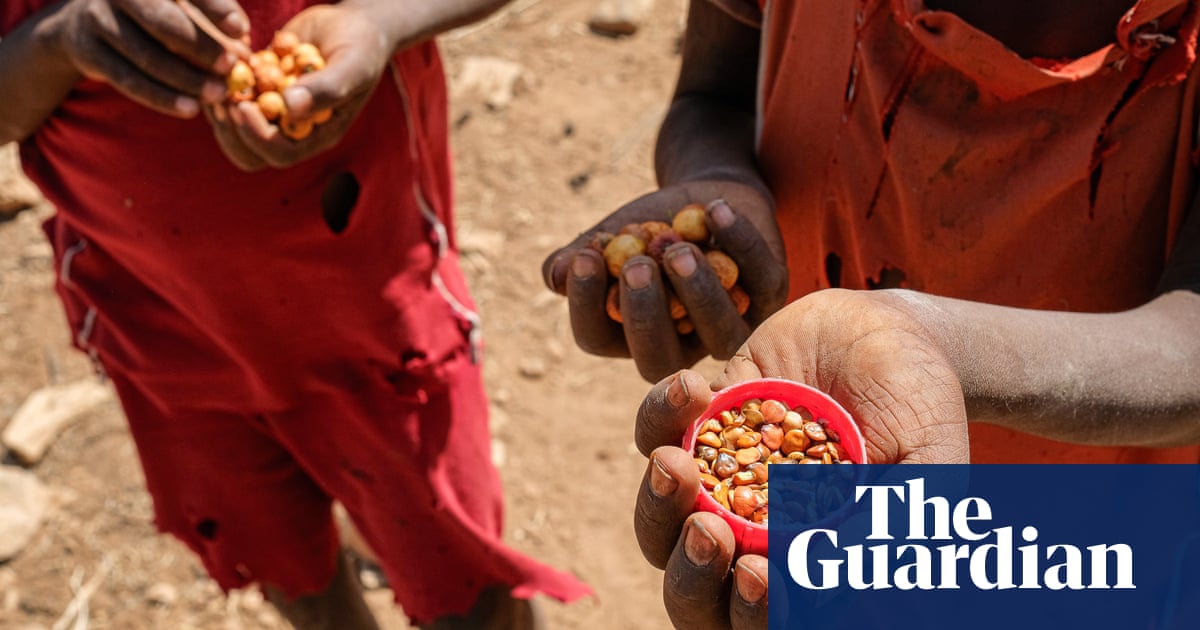
The grain stores are empty in the village of Tseykeme, where eight-year-old Gebremichael and his little brother, Gebreyohannes, spend their afternoons collecting small orange berries from the trees behind their home. The branches are too thorny to climb, so they knock down the berries by throwing stones.
Nothing goes to waste. After eating the flesh, they grind down the pits to get to the seeds inside. Each handful is enough to stave off hunger for a few more hours.
“We’ve been picking them for the last month,” says Abadi Adane, the boys’ father. “After they are finished, I don’t know what we will eat.”
The family planted their small patch of land in June, but the rains did not come and nothing grew. They survived for several months by selling their livestock. When that cash dried up, they turned to neighbours for donations of cups of grain. Now, though, no one has anything left to give.
Conditions are similar across this part of Ethiopia’s northern Tigray region, where stone farmsteads are overlooked by mountains with sheer red cliffs. The drought has turned the area into a dust bowl. Its gravelly fields are full of the stunted remains of dead crops.
“Every day we think about where to get food,” says Tsilaley Abraley, a single mother of six, who lives next door to Abadi. “We are always hungry.”
The drought is one of the worst in recent memory, but it is just the latest crisis to hit Tigray. The rains failed in the middle of a suspension of aid, introduced by the US and the United Nations in mid-March over a huge scheme to steal humanitarian grain by Ethiopian officials. The pause was extended to the rest of Ethiopia in June when the theft was discovered to be nationwide.
At the time, sorely needed food was only just starting to enter Tigray after a devastating two-year civil war. During the conflict, the government turned off Tigray’s internet and blocked aid trucks from entering, a strategy that prompted UN experts to accuse it of using starvation as a weapon of war.
Untold thousands died from hunger and untreated disease; more were killed in massacres. Nearly all of Tigray’s 6 million people needed humanitarian help. In mid-2021, the UN wanted to declare a famine in Tigray, but Ethiopia’s government blocked the move, claims Mark Lowcock, the world body’s humanitarian chief at the time.
Instead, the UN said at least 400,000 people were “living in famine-like” conditions. The US put the figure as high as 900,000.
When humanitarian agencies raised the alarm, Ethiopia’s government reacted furiously. It accused the UN’s World Food Programme of running guns to the rebels and expelled several top UN officials.
In Tseykeme, most families had their homes looted by Ethiopian soldiers or allied troops from Eritrea, while they hid in the nearby mountains. The troops took animals, sacks of grain and farming tools; several homes were ransacked twice. Sometimes, they burned what they could not carry. The Tigray rebels also demanded grain to feed their fighters, heaping yet more pressure on villagers.
“The combination of the aid suspension, the war and the drought – it’s just disastrous,” says Haben Assefa, an official in the nearby town of Yechila.
“The people here have nothing left,” he says. “Many will die if we don’t get immediate aid.”
One of the war’s fiercest battles was fought near Yechila. A few bombed-out trucks still sit on the road leading into the town. Many of its buildings are bullet-scarred. The main government office was gutted by looting and sits empty, its windows smashed and several rooms scorched and blackened.
At a building opposite, dozens of hungry people jostle to see if their names are on a list for the next aid distribution by the local government.
Masho Belay, 26, was among them. She used to sell vegetables at a market stall but the war took it all away.
“We eat only what our family or the government donates, but it is not enough,” she says. “My kids are always crying from hunger and asking me to give them food. It makes me feel terrible. Why am I in this desperate situation?”
The hunger crisis is not just confined to Tigray. Across Ethiopia, one in six of the 120 million population need food aid because of drought, conflict and rising inflation. The halt to aid worsened the situation, especially among internally displaced people who cannot return home to farm their land.
“The needs across the country are just huge,” says an aid worker who requested anonymity. “We would not be seeing this level of need without the suspension.”
Aid agencies resumed food aid deliveries in December after reforms were put in place to stop theft. These included putting GPS trackers on food trucks and removing Ethiopian officials from the distribution of humanitarian grain.
However, aid has been slow to get to those who need it. In Tigray, just 14% of people targeted by NGOs for food aid last month had received any by 21 January. Aid workers say the reformed system has problems that are still being ironed out.
It is hard to gauge the full scale of the crisis. The government has blocked a new Integrated Food Security Phase Classification (IPC) analysis since the last one pointed to famine in Tigray in 2021. The system is the standard tracking tool for aid agencies to calculate levels of hunger across the world.
Tigray officials are warning of an “unfolding famine” that could equal or eclipse the 1984-85 disaster, which inspired Live Aid. They have reported hundreds of deaths.
Last week, Ethiopia’s ombudsman said it had confirmed the starvation deaths of at least 351 people in Tigray and another 21 in the neighbouring Amhara region, which is also racked by drought and instability.
On Monday, after his return from a trip to Tigray, the UK’s Africa minister, Andrew Mitchell, urged immediate action “to stop a looming humanitarian catastrophe in its tracks” and launched a £100m fund to help children and pregnant women.
Yet Ethiopia’s government has dismissed fears of famine as “totally wrong” and accused Tigray’s leader of “politicising” the crisis. The famine warnings do not fit with a public relations push by the prime minister, Abiy Ahmed, to portray Ethiopia as “a nation of agricultural promise”.
This campaign centres on a claim that Ethiopia has gone from being a net importer of wheat to a self-sufficient wheat exporter, but instead of using the surplus to meet rising humanitarian needs at home, Ethiopia is selling the grain abroad to earn foreign currency for the cash-strapped economy.
On Tuesday, Abiy gave his fullest remarks yet on the crisis. In an address to parliament, he insisted his government was not sitting by and letting people starve, but had worked with aid agencies to send 50,000 tonnes of grain to Tigray in the last four months.
“What should the government of Tigray do? It must deliver those resources, however limited, to the worst-affected areas,” Abiy said.
Meanwhile, humanitarians have mostly kept quiet, fearful of losing their operating licences. In private, however, their language is stark.
A recent memo circulated among aid agencies warns that “starvation and death are inevitable … in considerable numbers” from March onwards in some areas of Tigray if aid does not reach them soon.
Another says child malnutrition rates are as high as 47% in parts of Oromia, Ethiopia’s biggest region. Both documents were reviewed by the Guardian.
In the sun-baked villages around Yechila, the rising sense of desperation is palpable. All coping mechanisms have been exhausted by three years of war, drought and the aid suspension. The people do not know what to do next.
“We need help,” says Meresa Hafte, whose 50-year-old mother, Leteselasie, lies on a stone bench at their home, weakened by hunger and racked by violent coughing fits. “Otherwise we are at the door of death,” he says.











